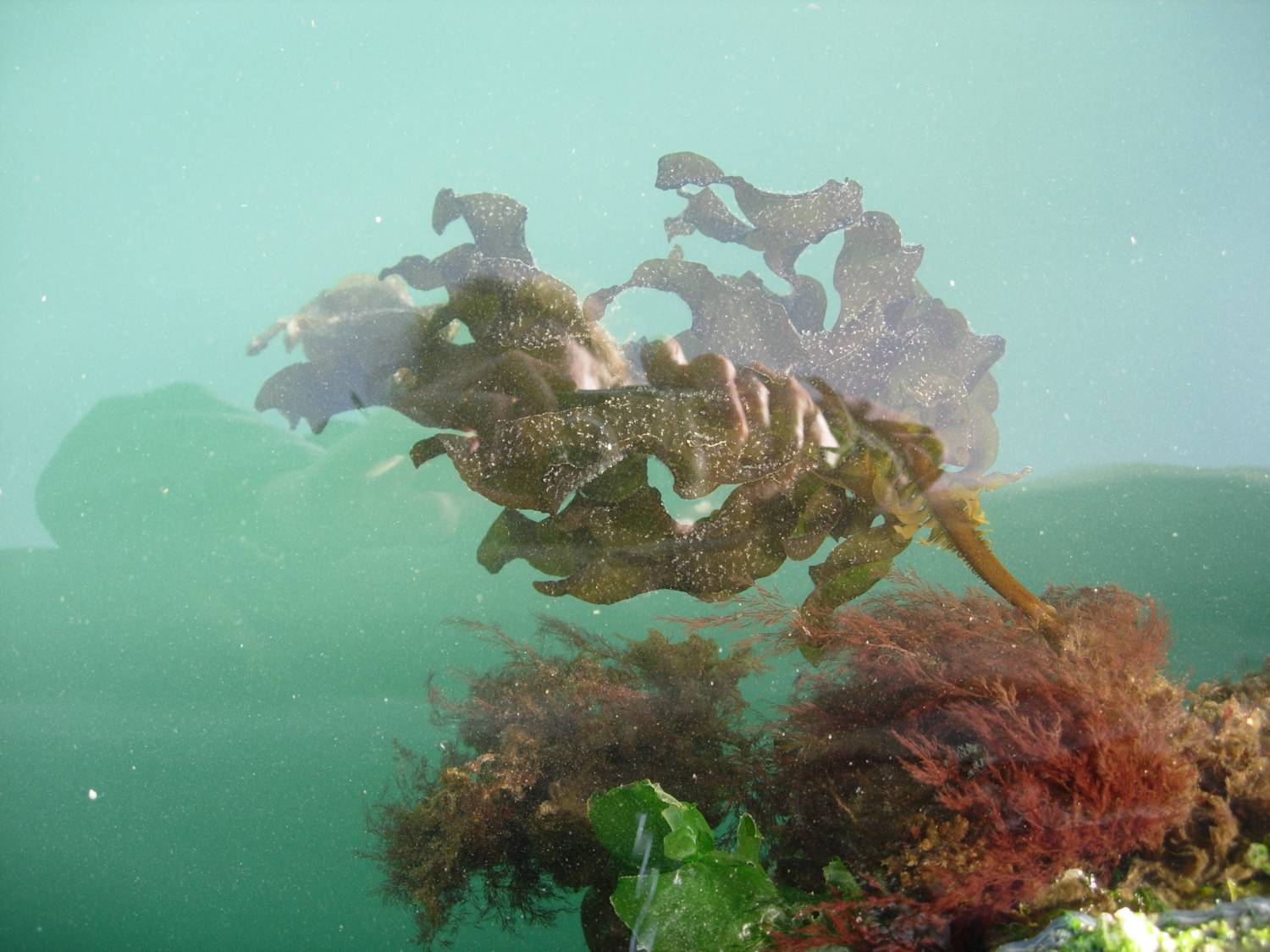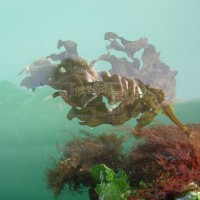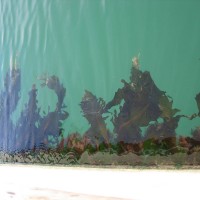
Japanese kelp - Undaria pinnatifida
Expand and collapse the sections below by clicking on the title or + / - icons.
Short description of Undaria pinnatifida, Japanese kelp
A large brown seaweed, the stipe has very wavy edges or ‘ruffles’ at the base, giving it a corrugated appearance. The blade is broad and flattened with a distinct midrib. The margins of the blade are wavy and ribbon-like at the base. Individuals can reach an overall length of one to three metres. Wakame is an annual species with two separate life stages.
Impact summary: Undaria pinnatifida, Japanese kelp
May compete for space with native species that live attached to hard surfaces, including native kelp species, due to its ability to grow quickly and colonise newly cleared areas. May be a nuisance algae, forming rafts where it reaches high levels of abundance and fouling jetties, vessels, moorings and buoys.
Habitat summary: Undaria pinnatifida, Japanese kelp
May be found on hard surfaces, including man-made structures from the low tide mark down as far as 15 metres in clear water. May also attach to bottom dwelling creatures, empty shells, loose cobbles and other seaweed species.
Overview table
| Environment | Marine |
|---|---|
| Species status | Non-Native |
| Native range | Northwestern Pacific |
| Functional type | Algae (macroalgae) |
| Status in England | Non-Native |
| Status in Scotland | Non-Native |
| Status in Wales | Non-Native |
| Location of first record | Hamble estuary |
| Date of first record | 1994 |
Origin
Native to cold temperate areas of Japan, China and Korea
First Record
The first GB record of Wakame is from the River Hamble Estuary, in the Solent in 1994.
Pathway and Method
Introduced to GB via secondary introductions from France, where it was introduced unintentionally with Pacific oysters and intentionally to be grown as a commercial food crop. It is thought to have been accidentally introduced to GB from continental Europe attached to ships’ hulls.
Species Status
Wakame has been accidentally introduced to Australia, New Zealand, Tasmania, and the Mediterranean Sea (France, Italy). It was deliberately introduced to Brittany for commercial exploitation. Following introduction, wild communities have been recorded in France, GB, Spain and Argentina. After being recorded from the Hamble in 1994 its range had extended between Ramsgate and Torquay, in 2004 and Wakame Is now also found on the shores and marinas around Plymouth and elsewhere on the South Coast of England.
Dispersal Mechanisms
Wakame has two distinct life stages. A large macroscopic (sporophyte) stage produces microscopic spores, which may be dispersed by water currents although sporophytes must settle in sufficient densities for fertilization to take place. Sporophytes may themselves attach to loose objects, allowing them to be naturally dispersed by currents.
Reproduction
In its native habitat, sporophytes grow rapidly in winter and spring when sea surface temperatures are 5-13°C. Growth is optimal at 10°C. The zoospores are released in late spring or early summer, when temperatures are between 7 and 20°C. The zoospores germinate at 20°C, and are sexually mature in about 3 weeks. At higher temperatures, the longevity and chances of germination of the sporophyte decline.Wakame’s two-stage life history, requires high densities of spores to settle together before fertilisation can occur. Release of spores can continue even when the stipes are devoid of their blade.
Known Predators/Herbivores
Possible predators in GB could include blue-rayed limpets (Helicon pellucidum), sea hares (Aplysia spp) and species of sea urchin.
Resistant Stages
The zoospore stage is microscopic, making detection difficult. This stage and can survive in a range of temperatures.
Habitat Occupied in GB
Found subtidally and in the very low intertidal can rapidly colonize new or recently disturbed man-made structures such as floating marina pontoons, rope, pylons, vessel hulls and navigation buoys. It can grow at depths of up to 18 m and can grow in a wide range of wave exposures, from sheltered marinas to the open coast. May also grow on loose cobbles and shells.
Native to cold temperate areas of Japan, China and Korea, it has been accidentally introduced to Australia, New Zealand, Tasmania, and the Mediterranean Sea (France, Italy). It was deliberately introduced into the North Atlantic, to Brittany for commercial exploitation. Following introduction, wild communities have been recorded in France, GB, Spain and Argentina. On the British coast its range had extended between Ramsgate and Torquay, in 2004. Wakame Is now also found on the shores and marinas around Plymouth and elsewhere on the South Coast of England.
Environmental Impact
Wakame is likely to compete for space and resources with native species of kelp and other brown seaweeds. It may also compete with other epibenthic animals and seaweeds.
Health and Social Impact
None known.
Economic Impact
Fisheries and mariculture: Industry may be adversely affected by increased costs associated with handling and marketing fouled shellfish. Commercially important species may also be adversely affected by indirect ecosystem impacts.
Identification
Biology, ecology, spread, vectors
Arenas, F., Bishop, J.D.D., Carlton, J.T., Dyrynda, P.J., Farnham, W.F., Gonzalez, D.J., Jacobs, M.W., Lambert, C., Lambert, G., Nielsen, S.E., Pederson, J.A., Porter, J.S., Ward, S. & Wood, C.A. (2006) Alien species and other notable records from a rapid assessment survey of marinas on the south coast of England. Journal of the Marine Biological Association of the United Kingdom, 86, 1329-1337.
Castric-Fey, A., Girard, A. & L'Hardy-Halos, M.T. (1993) The distribution of Undaria pinnatifida (Phaeophyceae, Laminariales) on the coast of St. Malo (Brittany, France). Botanica Marina, 36, 351-358.
Castric-Fey, A., Beaupoil, C., Bouchain, J., Pradier, E. & L’Hardy-Halos, M.T. (1999) The introduced alga Undaria pinnatifida (Laminariales, Alariaceae) in the rocky shore ecosystem of the St Malo area: growth rate and longevity of the sporophyte. Botanica Marina, 42, 83-96.
Sliwa, C., Johnson, C.R., Hewitt, C.L. (2006) Mesoscale dispersal of the introduced kelp Undaria pinnatifida attached to unstable substrata. Botanica Marina, 49, 396–405.
Farell, P. & Fletcher, R. (2000) The biology and distribution of the kelp, Undaria pinnatifida (Harvey) Suringar, in the Solent. Amsterdam: Elsevier Science B.V.
http://www.marlin.ac.uk/marine_aliens/species.asp?SpID=22
http://www.marlin.ac.uk/speciesinformation.php?speciesID=4547
Management and impact
Wotton, D.M., O’Brien, C., Stuart, M.D. & Fergus, D.J. (2004) Eradication success down under: heat treatment of a sunken trawler to kill the invasive seaweed Undaria pinnatifida. Marine Pollution Bulletin, 49, 844-849.
General
Spotted this species?
Distribution map
View the Distribution map for Japanese kelp, Undaria pinnatifida from NBN Atlas
ID Sheet
ID Sheet for Undaria pinnatifida . See a full list of non-native species ID Sheets.
Risk assessment
Risk assessment for Undaria pinnatifida. See a full list of non-native species Risk assessments.
Legislation
This species is listed under Schedule 9 of the Wildlife and Countryside Act 1981. Read more about Non-native species legislation.



